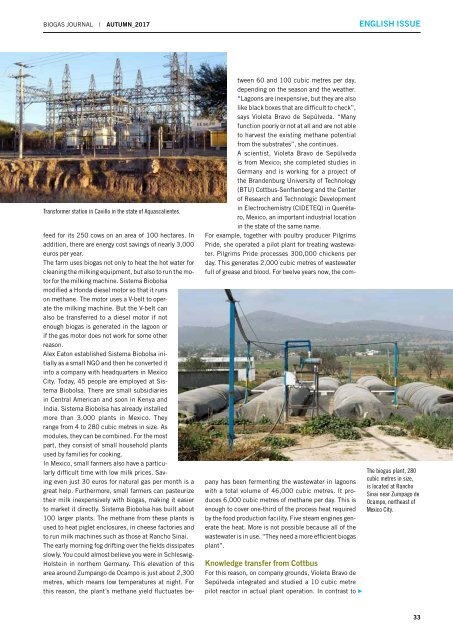You also want an ePaper? Increase the reach of your titles
YUMPU automatically turns print PDFs into web optimized ePapers that Google loves.
Biogas Journal | <strong>Autumn</strong>_<strong>2017</strong> English Issue<br />
Transformer station in Cavillo in the state of Aquascalientes.<br />
feed for its 250 cows on an area of 100 hectares. In<br />
addition, there are energy cost savings of nearly 3,000<br />
euros per year.<br />
The farm uses biogas not only to heat the hot water for<br />
cleaning the milking equipment, but also to run the motor<br />
for the milking machine. Sistema Biobolsa<br />
modified a Honda diesel motor so that it runs<br />
on methane. The motor uses a V-belt to operate<br />
the milking machine. But the V-belt can<br />
also be transferred to a diesel motor if not<br />
enough biogas is generated in the lagoon or<br />
if the gas motor does not work for some other<br />
reason.<br />
Alex Eaton established Sistema Biobolsa initially<br />
as a small NGO and then he converted it<br />
into a company with headquarters in Mexico<br />
City. Today, 45 people are employed at Sistema<br />
Biobolsa. There are small subsidiaries<br />
in Central American and soon in Kenya and<br />
India. Sistema Biobolsa has already installed<br />
more than 3,000 plants in Mexico. They<br />
range from 4 to 280 cubic metres in size. As<br />
modules, they can be combined. For the most<br />
part, they consist of small household plants<br />
used by families for cooking.<br />
In Mexico, small farmers also have a particularly<br />
difficult time with low milk prices. Saving<br />
even just 30 euros for natural gas per month is a<br />
great help. Furthermore, small farmers can pasteurize<br />
their milk inexpensively with biogas, making it easier<br />
to market it directly. Sistema Biobolsa has built about<br />
100 larger plants. The methane from these plants is<br />
used to heat piglet enclosures, in cheese factories and<br />
to run milk machines such as those at Rancho Sinai.<br />
The early morning fog drifting over the fields dissipates<br />
slowly. You could almost believe you were in Schleswig-<br />
Holstein in northern Germany. This elevation of this<br />
area around Zumpango de Ocampo is just about 2,300<br />
metres, which means low temperatures at night. For<br />
this reason, the plant’s methane yield fluctuates between<br />
60 and 100 cubic metres per day,<br />
depending on the season and the weather.<br />
“Lagoons are inexpensive, but they are also<br />
like black boxes that are difficult to check”,<br />
says Violeta Bravo de Sepúlveda. “Many<br />
function poorly or not at all and are not able<br />
to harvest the existing methane potential<br />
from the substrates”, she continues.<br />
A scientist, Violeta Bravo de Sepúlveda<br />
is from Mexico; she completed studies in<br />
Germany and is working for a project of<br />
the Brandenburg University of Technology<br />
(BTU) Cottbus-Senftenberg and the Center<br />
of Research and Technologic Development<br />
in Electrochemistry (CIDETEQ) in Querétaro,<br />
Mexico, an important industrial location<br />
in the state of the same name.<br />
For example, together with poultry producer Pilgrims<br />
Pride, she operated a pilot plant for treating wastewater.<br />
Pilgrims Pride processes 300,000 chickens per<br />
day. This generates 2,000 cubic metres of wastewater<br />
full of grease and blood. For twelve years now, the company<br />
has been fermenting the wastewater in lagoons<br />
with a total volume of 46,000 cubic metres. It produces<br />
6,000 cubic metres of methane per day. This is<br />
enough to cover one-third of the process heat required<br />
by the food production facility. Five steam engines generate<br />
the heat. More is not possible because all of the<br />
wastewater is in use. “They need a more efficient biogas<br />
plant”.<br />
Knowledge transfer from Cottbus<br />
For this reason, on company grounds, Violeta Bravo de<br />
Sepúlveda integrated and studied a 10 cubic metre<br />
pilot reactor in actual plant operation. In contrast to<br />
The biogas plant, 280<br />
cubic metres in size,<br />
is located at Rancho<br />
Sinai near Zumpago de<br />
Ocampo, northeast of<br />
Mexico City.<br />
33

















